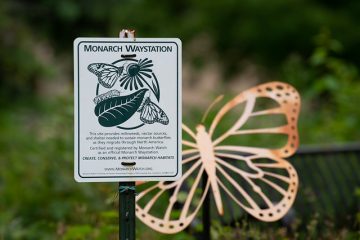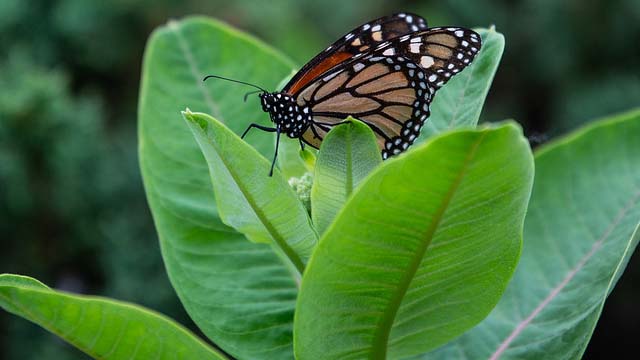Three large monarch caterpillars were seen this week nibbling on the leaves of milkweed growing in a landscape bed at the University of Wisconsin Oshkosh. It’s a scene not uncommon at a campus that champions itself with sustainable and environmentally friendly practices and a large number of native plants and trees that provide habitat for insects, birds and other creatures.

Monarchs need milkweed
Milkweed used to have a bad rap. Crews were mowing it on the sides of highways and no one would purposely put that “weed” into a planting bed. Now recognized as vital to the continuance of monarch butterflies, milkweed is not only accepted, but sought after.
Walk around the UWO campus, and you’ll see milkweed plants in a number of locations—even in unlikely places—emerging between clusters of flowers and shrubs.
“Wherever milkweed sprouts on campus, we let it grow,” said UWO alumna Anita Carpenter ’83 MS, of Oshkosh, a retired pharmacist who spends time nearly each day in spring and summer tending to the vast number of plants and wildlife on the expansive university grounds.
There are several types of milkweed and monarch butterflies seek it out to lay their eggs. Caterpillars emerge from the eggs and begin munching tender leaves of the milkweed plant.
 The campus has been designated since 2015 as a monarch way station by conservation group, Monarch Watch—providing plenty of milkweed plants that allow monarchs to breed and migrate.
The campus has been designated since 2015 as a monarch way station by conservation group, Monarch Watch—providing plenty of milkweed plants that allow monarchs to breed and migrate.
The cold weather this spring delayed the emergence of milkweed and presented just the right height, 6-8-inch tall plants, according to Carpenter, who describes herself as a naturalist and volunteer prairie-keeper on campus.
Journeying south
Shannon Davis-Foust is a senior lecturer of biology and environmental studies at UW Oshkosh. She obtained a grant last year through Monarch Watch and with the help of UWO and elementary students, planted 400 whorled milkweed at Oakwood Elementary School in Oshkosh. People help tag monarchs each fall for Monarch Watch.
 “Monarchs are the only butterfly species in North America known to migrate to a warmer climate in the fall,” Davis-Foust said. “Using this unique adaptation, monarch numbers are estimated by measuring the land area their population covers at their overwintering habitat in the mountain forest of Michoacan, Mexico.”
“Monarchs are the only butterfly species in North America known to migrate to a warmer climate in the fall,” Davis-Foust said. “Using this unique adaptation, monarch numbers are estimated by measuring the land area their population covers at their overwintering habitat in the mountain forest of Michoacan, Mexico.”
She said depending on the source of information, monarch numbers increased just above the projected threshold for migratory collapse, but overall monarch population estimates have continued on an overall downward trend since they were first measured during the winter of 1994-1995.
The decline of monarchs is thought to be due to the increased use of herbicides. Milkweed, the only plant that monarch caterpillars can survive on, is especially sensitive to Roundup–a popular herbicide, Davis-Foust said.
An adviser to the Wisconsin Monarch Collaborative, her farm property, like UW Oshkosh, is registered as a monarch way station.
A report this week by The Xerces Society said there were alarmingly low numbers of western monarchs overwintering in California—just 28,429 were counted over Thanksgiving 2018 at 213 sites. During Thanksgiving 2017, there were 192,668 western monarchs counted at 263 sites.
Davis-Foust said both (western and eastern) populations are near the projected threshold for migratory collapse, with the eastern population doing slightly better of the two.

Gerald and Anita Carpenter
Boosting monarch population
Carpenter agrees that the state’s monarch population has dropped dramatically since the 1990s. Increased pesticide/herbicide use, land development, extreme weather and collisions with vehicles have all contributed to the loss of monarchs.
Davis-Foust said the Wisconsin Monarch Collaborative advises landowners to plant Wisconsin’s native milkweed species for monarch caterpillars and to make sure that other nectar sources are available to adult butterflies. The monarch species is not presently classified as a threatened or endangered species under the U.S. Endangered Species Act.
She said more overwintering counts will take place before a listing decision will be issued in December 2020 by the U.S. Fish and Wildlife Service to determine if monarchs should be granted federal protection under the Endangered Species Act.
A potential major conservation initiative could help. Davis-Foust said a decision is pending on a right-of-way conservation agreement with non-federal public entities, including 40 public utility companies that would invest in creating and protecting monarch habitat on millions of acres of public energy and transportation lands.
“If approved, this would be, by far, the largest scale monarch conservation effort to date,” she said.
Helping at home
Changing one’s mindset when it comes to herbicides and pesticides and planting milkweed and a variety of nectar plant sources for butterflies are great first steps.
“Each of us can do our little part,” Carpenter said.
Learn more:

